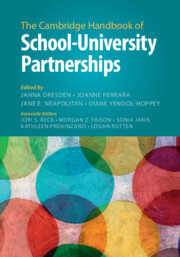Book contents
- The Cambridge Handbook of School–University Partnerships
- The Cambridge Handbook of School–University Partnerships
- Copyright page
- Contents
- Figures
- Tables
- Contributors
- Foreword
- Preface
- Acknowledgments
- Part I The History and Conceptual Foundations of School–University Partnerships
- Part II Teachers and Learning to Teach in School–University Partnerships
- Part III Equity and Student Learning in School–University Partnerships
- Introduction to Part III: Equity and Student Learning in School–University Partnerships
- 18 Examining the Link Between School–University Partnerships and Student Learning Outcomes
- 19 Educational Equity and Student Learning in School–University Partnerships
- 20 Beyond Educator Preparation
- 21 Equity and Anti-racism at the Center of the Work
- 22 Commentary: Equity and Social Justice in the Context of School–University Partnerships
- 23 Commentary: Synergy and Sankofa
- 24 Commentary: Situating School–University Partnership Research for Social Justice
- Part IV Leadership in School–University Partnerships
- Part V Community Schools as School–University Partnerships
- Part VI Inquiry and Innovation in School–University Partnerships
- Part VII Funding, Policy, and the Politics of School–University Partnerships
- Part VIII Looking at School–University Partnerships across Geographic and Cultural Borders
- Index
- References
20 - Beyond Educator Preparation
What Are School–University Partnerships and How Can They Contribute to Racial Equity?
from Part III - Equity and Student Learning in School–University Partnerships
Published online by Cambridge University Press: 05 November 2025
- The Cambridge Handbook of School–University Partnerships
- The Cambridge Handbook of School–University Partnerships
- Copyright page
- Contents
- Figures
- Tables
- Contributors
- Foreword
- Preface
- Acknowledgments
- Part I The History and Conceptual Foundations of School–University Partnerships
- Part II Teachers and Learning to Teach in School–University Partnerships
- Part III Equity and Student Learning in School–University Partnerships
- Introduction to Part III: Equity and Student Learning in School–University Partnerships
- 18 Examining the Link Between School–University Partnerships and Student Learning Outcomes
- 19 Educational Equity and Student Learning in School–University Partnerships
- 20 Beyond Educator Preparation
- 21 Equity and Anti-racism at the Center of the Work
- 22 Commentary: Equity and Social Justice in the Context of School–University Partnerships
- 23 Commentary: Synergy and Sankofa
- 24 Commentary: Situating School–University Partnership Research for Social Justice
- Part IV Leadership in School–University Partnerships
- Part V Community Schools as School–University Partnerships
- Part VI Inquiry and Innovation in School–University Partnerships
- Part VII Funding, Policy, and the Politics of School–University Partnerships
- Part VIII Looking at School–University Partnerships across Geographic and Cultural Borders
- Index
- References
Summary
Through school–university partnerships (SUPs), individuals and organizations collaborate across the long-standing boundaries that exist between preschool through high school (p-12) and postsecondary education. Partnerships between institutions of higher education and schools take many forms and exist for many purposes; SUPs are boundary-spanning collaborative efforts that require individuals and groups to cross systemic divides in the United States educational system (Burns & Baker, 2016; Zeichner, 2010). In the first half of this chapter, we explore a broad definition for SUPs, define types of SUPs and briefly trace their development since the late 1800s. In the second half of this chapter, we apply three aspects of critical race theory (CRT) to SUPs, considering how SUPs might be facilitated to intentionally pursue racial equity.
Information
- Type
- Chapter
- Information
- The Cambridge Handbook of School–University Partnerships , pp. 323 - 340Publisher: Cambridge University PressPrint publication year: 2025
References
Accessibility standard: WCAG 2.1 AA
Why this information is here
This section outlines the accessibility features of this content - including support for screen readers, full keyboard navigation and high-contrast display options. This may not be relevant for you.Accessibility Information
Content Navigation
Allows you to navigate directly to chapters, sections, or non‐text items through a linked table of contents, reducing the need for extensive scrolling.
Provides an interactive index, letting you go straight to where a term or subject appears in the text without manual searching.
Reading Order & Textual Equivalents
You will encounter all content (including footnotes, captions, etc.) in a clear, sequential flow, making it easier to follow with assistive tools like screen readers.
Visual Accessibility
You will still understand key ideas or prompts without relying solely on colour, which is especially helpful if you have colour vision deficiencies.
Structural and Technical Features
You gain clarity from ARIA (Accessible Rich Internet Applications) roles and attributes, as they help assistive technologies interpret how each part of the content functions.
